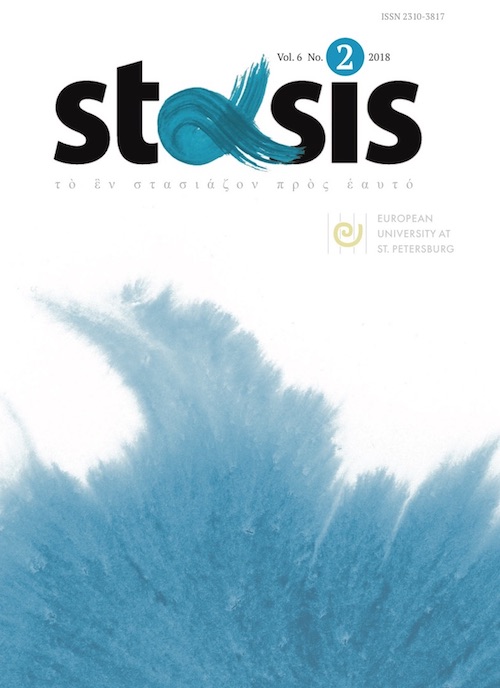Пробуждение Лазаря: забытые фигуры — масса или избыток?
Аннотация
Цель данной статьи — помыслить фигуру, сегодня в значительной степени забытую радикальной философией и коммунистической теологией, фигуру (или фигуры) библейского Лазаря. Ее отсутствие в пространстве актуальных дискуссий может быть связано с тем, что Балибар назвал
непроходящей «боязнью масс», с их политическим пробуждением, которое обычно ассоциируется с насилием, провалом, беспорядочным шумом или отсутствием политической программы / организации. В первой части своей статьи я предлагаю детальное прочтение двух историй о Лазаре, имеющихся в новозаветных текстах. Одного из этих Лазарей (Евангелие от Иоанна) можно рассматривать не только как прообраз воскресения Иисуса, но еще и как пробуждение политического «избытка», который сотрясает основы старого порядка и не может быть с легкостью встроен в порядок новый. Второй Лазарь (Евангелие от Луки) подобен стоической фигуре, остающейся за рамками политической жизни и получающей свое оправдание лишь в мире загробном. Напряжение, возникающее между этими фигурами бедняка / исключенного, было, в свою очередь, проанализировано в работах трех радикальных мыслителей: Фуко, Маркса и Фанона. Краткий панорамный анализ этого теоретического наследия, связанного с Лазарем, представлен во второй части статьи: ранние дискуссии о проказе и стратегических, пространственных и суверенных разделениях на внешнее и внутреннее у Фуко, колебания Маркса между «избыточным населением» и «люмпен- пролетариатом» и, наконец, фаноновский концепт «люмпен- пролетариата», которому предстоит стать во главе будущих революций.
Литература
Aquino, Thomas de (1895). “Summa Theologiæ secunda pars secundæ partis a quæstione XXV ad XXVI.” Corpus Thomisticum. http://www.corpusthomisticum.org/ sth3025.html.
Agamben, Giorgio (1998). Homo Sacer. Stanford: Stanford University Press.
Althusser, Louis (1971). “Ideology and Ideological State Apparatuses.” In Lenin and Philosophy and Other Essays, 127–89. London: New Left Books.
Althusser, Louis (2005). For Marx. London: Verso.
Althusser, Louis (2006). Philosophy of the Encounter. Later Writings, 1978–1987, London: Verso.
Badiou, Alain (2003). Saint Paul. Stanford: Stanford University Press.
Balibar, Etienne (1989). “Spinoza, the Anti-Orwell: The Fear of the Masses.” Rethinking Marxism 2.3: 104–39.
Bible (2018). “Search, Read, Study the Bible in Many Languages.” Bible Hub. https://biblehub.com.
Boer, Roland (2015). “Translating Politics and Religion: A New Model.” Stasis. 3.2: 10–28.
Buck-Morss, Susan (2002). Dreamworld and Catastrophe. Cambridge, MA: MIT Press. Bussard, Robert (1987). “The ’Dangerous Class’ of Marx and Engels: The Rise of the Idea of the Lumpenproletariat.” History of European Ideas 8.6: 675–92.
Clover, Joshua (2016). Riot. Strike. Riot. London: Verso.
Chrysostom, John (1978). A Select Library of the Nicene and Post-Nicene Fathers of the Christian Church, Vol. XIV: Chrysostom. Homilies on the Gospel of St. John and the Epistle to the Hebrews. Ed. Philip Schaff. Grand Rapids, MI: William B. Eerdmans.
Dean, Jodi (2012). Communist Horizon. New York: Verso.
Denning, Michael (2010). “Wageless Life.” New Left Review 66 (November–December): 79–97.
Dolar, Mladen (1993). “Beyond Interpellation.” Qui Parle 6.2: 73–96.
Fanon, Frantz, (1991). The Wretched of the Earth. New York: Grove Press. Fanon, Frantz (2004). The Wretched of the Earth. New York: Grove Press.
Federici, Silvia (2004). Caliban and the Witch: Women, the Body and Primitive Accumulation. New York: Autonomedia.
Foucault, Michel (2006). History of Madness. New York: Routledge.
Gollwitzer, Helmut (1970). The Rich Christians and Poor Lazarus. Edinburgh: St. Andrews Press.
Habjan, Jernej (2014). “The Eighteen Brumaire of Jacques Derrida.” In (Mis)readings of Marx in Continental Philosophy, eds. Jessica Whyte and Jernej Habjan, 128–44. London: Palgrave Macmillan.
Hardt, Michael, and Antonio Negri (2000). Empire. Cambridge, MA: Harvard University Press.
Hegel, Friedrich (1991). Elements of the Philosophy of Right. Trans. H. B. Nisbet. Cambridge: Cambridge University Press.
Lenin, Vladimir (1902). “What Is to Be Done?” Marxists Internet Archive. https://www.marxists.org/archive/lenin/works/download/what-itd.pdf.
Lih, Lars (2007). “Lenin and the Great Awakening,” in Lenin Reloaded: Toward a Politics of Truth, eds. Sebastian Budgen, Stathis Kouvelakis and Slavoj Žižek, 283–97. Durham, NC: Duke University Press.
Lih, Lars (2015). “The Shield of Aeneas: Narratives of World Historical Mission, Ancient and Modern.” Stasis 3.2: 160–80.
Little, Daniel (2009). “Marx and Taipings.” Understanding Society. https://understandingsociety.blogspot.com/2009/02/marx-and-taipings0.html.
Lorey, Isabel (2008). “Identitary Immunity and Strategic Immunization.” Trans. Catherine Framm. Transversal Journal. http://eipcp.net/transversal/1107/lorey/en/print#_ftnref8.
Löwy, Michael (1996). The War of Gods. Religion and Politics in Latin America. London: Verso.
Martin, Dominic (2017). “The Last Men before the Last: A Russian Messianic Revival in the Twilight of History.” In Beyond Neoliberalism. Approaches to Social Inequality and Difference, eds. Marian Burchardt and Gal Kirn, 155–90. Cham: Palgrave Macmillan.
Marx, Karl, and Friedrich Engels (1975–2005). Marx and Engels Collected Works (MECW). New York: International Publishers.
Mastnak, Tomaž (2001). Crusading Peace: Christendom, the Muslim World, and Western Political Order. Berkeley: University of California Press.
Močnik, Rastko (1999). 3 teorije: ideologija, nacija, institucija [3 Theories: ideology, na- tion and institution]. Ljubljana: Založba.
Prosic, Tamara (2015). “Cultural Hegemony, Sobornost, and the 1917 Russian Revolution.” Stasis 3.2: 204–25.
Rancière, Jacques (1999). Disagreement. Minneapolis: University of Minnesota Press. Ruda, Frank (2011). Hegel’s Rabble. New York: Bloomsbury.
Tirkkonen, Sanna (2015). “Power, Religion, and Simulacrum — Foucault on the Cult of Dionysus.” Stasis 3.2: 302–22.
Walker, Gavin (2018). “Surplus Alongside Excess: Uno Kōzō, Imperialism, and the Theory of Crisis.” Viewpoint Magazine. https://www.viewpointmag.com/2018/02/01/ surplus-alongside-excess-uno-kozo-imperialism-theory-crisis.
Whalen, Brett (2009). Dominion of God. Cambridge, MA: Harvard University Press. Worsley, Peter (1972). “Fanon and the ’Lumpenproletariat’.” Socialist Register 9: 193–230.
Žižek, Slavoj (2008). In Defense of Lost Causes. London: Verso.







